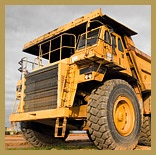The Right Flux for the Job
High-temperature fluxes are used with brazing filler materials having melting temperatures of 1600°F (870°C) - 2000°F (1100°C), or 2200°F (1205°C) for boron-modified filler.  These fluxes are useful for applications where higher-temperature alloys are needed for strength, such as mining and construction tooling. High-temperature fluxes also provide cost-effective brazing of steels and coppers with non-silver-bearing filler metals.
These fluxes are useful for applications where higher-temperature alloys are needed for strength, such as mining and construction tooling. High-temperature fluxes also provide cost-effective brazing of steels and coppers with non-silver-bearing filler metals.
In the brazing process, flux is the chemical compound applied to joint surfaces just before brazing. As the temperature of the joint area is increased, the flux melts and becomes active. Chemical reactions occur when metals are exposed to air-most notably, oxidation-and this is accelerated as temperatures increase. So, the job of flux in brazing is to promote the formation of a joint by protecting the base metal and the filler metal from this oxidation. Removing the surface oxides, the flux reduces surface tension and helps the filler metal to flow freely.
How do you choose the correct flux? Basically, it depends on the base metal, filler metal, and brazing process/heating method. That is why you will see the American Welding Society (AWS) categorize fluxes according to:
- Application base metals
- Applicable brazing filler metals
- Activity temperature ranges
High-Temperature Fluxes
The classification AWS A5.31 FB3-D specifies brazing fluxes intended for torch, furnace, and induction brazing of steel, nickel and its alloys, and carbides, using high-temperature filler metals. These fluxes are made from boric acid, borates, and complex fluorine compounds and have a higher active temperature range. Following are Lucas-Milhaupt products in this classification.
- Lucas-Milhaupt Handy Flux® Hi-Temp is water-based active fluoride/borate-type flux, in paste form. It is recommended for use with filler metals that flow between 1600°F (870°C) - 2000°F (1100°C). Applications include brazing of steel, stainless steel, copper, copper alloys, nickel, and nickel alloys with high-melting brazing filler metals. Handy Flux Hi-Temp is suitable for use with most heating methods, including torch, induction, or furnace.
- Lucas-Milhaupt Handy Flux® Hi-Temp Boron Modified is a water-based active fluoride/borate-type flux in paste form which has been specially formulated for excellent adhesion when dipped or brushed on parts. The addition of boron increases the temperature of flux. It is recommended for use with filler metals that flow between 1600°F (870°C) - 2200°F (1205°C). Applications include general-purpose brazing in applications involving steel, stainless steel, copper, copper alloys, nickel, and nickel alloys with high-melting brazing filler metals. It is suitable for torch, induction, or furnace brazing.
Filler Metals - Alloys
The above high-temperature fluxes are typically matched with the following alloys for high-quality, high-strength joints.
- Lucas-Milhaupt CDA 680 Bronze Brazing Alloy is a low-fuming bronze filler metal used for brazing of ferrous and non-ferrous alloys such as steel and copper. This alloy is typically used where close fit-up cannot be maintained and high brazing temperatures are permissible. Handy Flux Hi-Temp should be used with this alloy. Heating methods include torch, induction, and furnace.
- Lucas-Milhaupt CDA 681 Bronze Brazing Alloy is also a low-fuming bronze filler metal used for brazing of ferrous and non-ferrous alloys such as steel and copper. CDA 681 offers the benefit of nickel in its composition plus a slightly broader brazing temperature range. Handy Flux Hi-Temp should be used with this alloy. Heating methods include torch, induction, and furnace.
- Lucas-Milhaupt Hi-Temp® 548 is a modified nickel-silver filler metal primarily used to join tungsten carbide to steel. Brazing is often combined with heat treatment of steel tool bits. This filler has good high-temperature strength and toughness. It exhibits excellent flow and wetting on tungsten carbides and tool steels, especially when induction brazed. For induction, torch, or furnace brazing, use Handy Ti-Temp Boron-Modified Flux.
- Lucas-Milhaupt Hi-Temp® 675 is a copper-nickel-manganese filler metal designed for intermediate temperature brazing of carbides, cast irons, steel, stainless steels, and nick-base heat-resistant alloys. It exhibits excellent flow and wetting on tungsten carbide, tool steel and stainless steels, with a narrow melting range for free flow at and above the liquidus temperature. Hi-Temp, Handy Hi-Temp DB, or Handy Hi-Temp Boron-Modified Flux should be used with this filler metal.
Applications
Especially for the high-strength requirements of brazing mining and construction tooling, Hi-Temp 548 and 675 will be most useful. All the above alloys will provide cost-effective brazing of steels and coppers which are not silver-bearing.
Brazing Process
Typically, torch or induction brazing may be used with high-temperature fluxes. Occasionally, manufacturers may use furnace brazing. Keep in mind that corrosive flux residue sometimes requires mechanical removal, such as bead blasting.
Conclusion
High-temperature fluxes are used with brazing filler materials having melting temperatures between 1600°F (870°C) - 2000°F (1100°C), or 2200°F (1205°C) for boron-modified fluxes. These fluxes are useful for applications where higher-temperature alloys are needed for strength, such as mining and construction tooling. High-temperature fluxes also provide cost-effective brazing of steels and coppers which are not silver-bearing.
Questions? Lucas-Milhaupt's experts can help you navigate the challenges of joining metals. For further information on fluxes and filler metals, please see our products or contact us.

